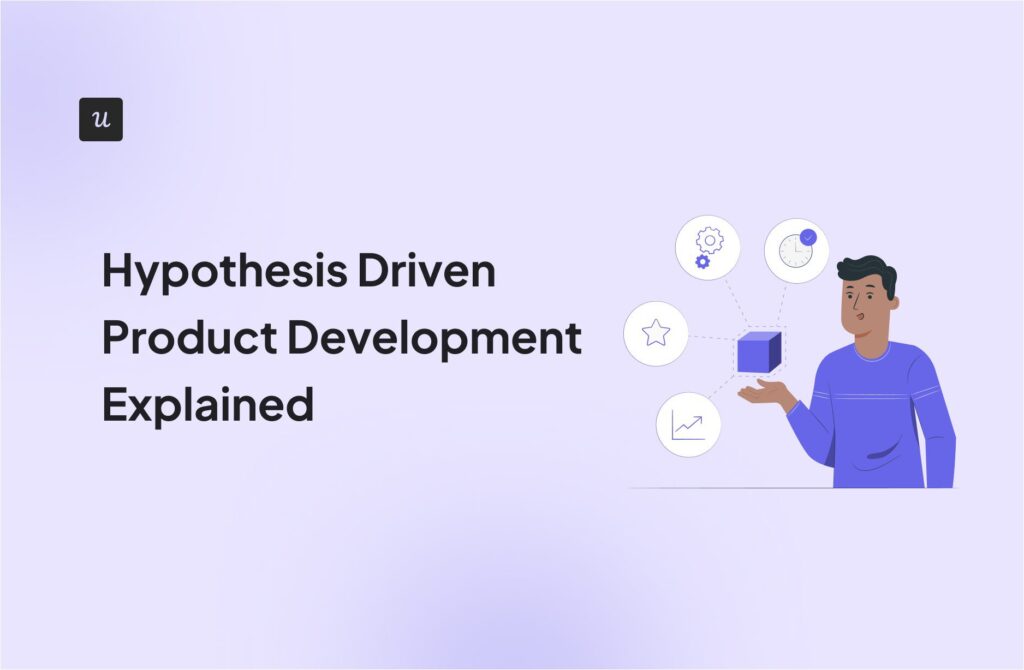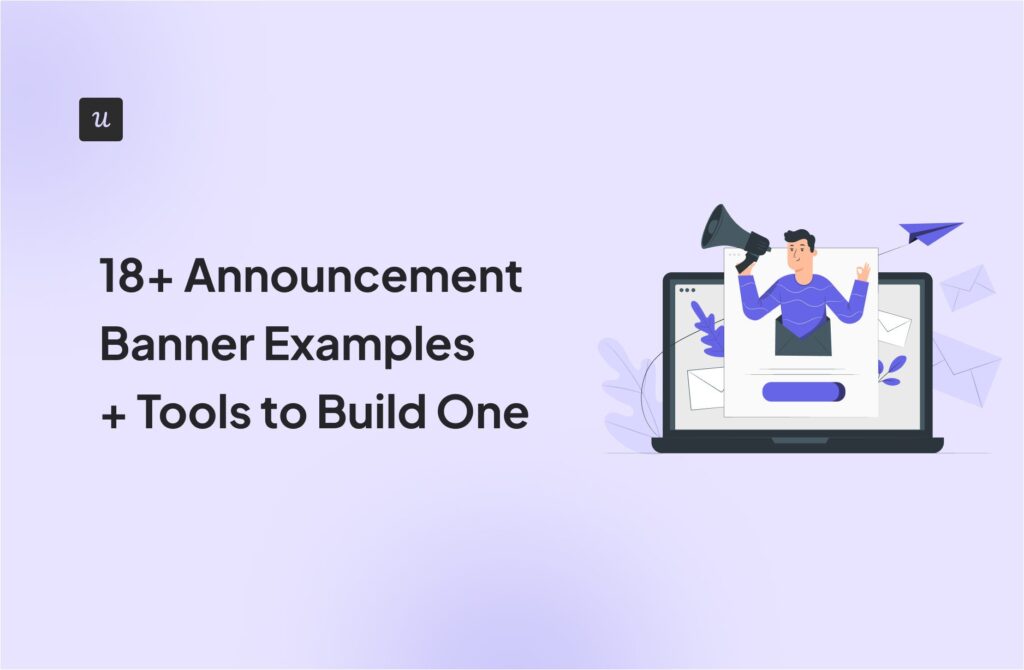
Try Userpilot Now
See Why 1,000+ Teams Choose Userpilot

What is a product development strategy?
A product development strategy is a plan that outlines the process of bringing a new product to life or improving an existing product.
It encompasses everything from identifying a market need to the product launch and beyond.
The benefits of a product development strategy
A product development strategy sets the direction and focus and gets everyone working in the same direction with a shared vision.
Thanks to the thorough market research required to develop this strategy, the product development team can identify and minimize potential roadblocks early on.
All this helps you find new relevant markets, penetrate deeper into existing markets, diversify your portfolio, enhance the customer experience, and meet revenue goals.
What are the stages of the product development process?
To craft a great product development strategy, first, you need to understand the product development process.
Although the process isn’t typically linear, it tends to follow seven stages.
- Idea generation: The first step to developing any product is ideation. This involves brainstorming for new product ideas and generating potential product concepts.
- Market research: This step involves conducting thorough market research and competitor analysis to screen the initial list of ideas. The product team checks for market potential, risk levels, and the product’s technical feasibility.
- Technical specifications: Here, you’ll translate your product idea into core features and functionalities for a specific target audience.
- Roadmapping: This stage involves creating a working business strategy for your product. This means prioritizing features, defining a development timeline, and creating a marketing strategy.
- Product development: Finally, it’s time to start building. This is when you turn your product concept into an actual product. For this stage, a minimum viable product (MVP) will do.
- MVP release and feedback collection: Also known as the test marketing stage, this stage involves releasing the MVP to the market and collecting early user feedback to identify any issues.
- Continuous iteration: This stage is divided into two phases. The first involves launching the final product after a successful MVP release. The second involves continuously collecting customer feedback to ensure the product continues to meet their needs.

Proactive vs. reactive product development strategies
Although you can choose from a variety of product development strategies, they can often be divided into two groups: proactive and reactive.
Proactive product development strategies try to anticipate future needs and shape the market. Companies that adopt this strategy invest heavily in research and development to enable them to predict future trends and innovate accordingly.
Reactive product development strategies, however, respond to existing product trends and competitor actions. They observe competitor innovations and react to customer requests to meet market demands.
Canva, for example, developed a user-friendly, on-the-go graphic creation tool that created a whole new market. HubSpot, meanwhile, identified a need within the CRM software market and addressed it.

5 types of product development strategies
In case you’re still wondering what a product development strategy looks like, let’s consider five examples.
Market expansion
The market expansion strategy involves expanding the market reach of an existing product. This means broadening your target market by offering an existing product to new markets.
Market expansion can go either of two ways. The first involves opening up your product to new market segments. Slack did this when it expanded from being a tech-focused product to targeting various industries.
The second involves bringing your product to international markets where it originally didn’t exist. Spotify, for example, expanded out of Sweden to become a global product.
Both expansion types require some form of product development strategy.
For example, when expanding to a new geographical area, in most cases, you will need to invest in localization to better meet the needs of the target audience. One example of this is translating product content into the target user’s native language.

Product improvement
The product improvement strategy involves enhancing an existing product to satisfy customer needs better or gain a competitive advantage.
It is often a reactive strategy in response to user feedback or technological advances.
A famous example is Dropbox, which has made efforts to improve its file-sharing speeds and storage capacity in order to remain a market leader.
Another example could be resolving bugs and UX issues to enhance the user experience.

Product extension
Product extension involves creating new products or services closely related to the existing product. The strategy is used to develop different but related features that improve the existing product.
For example, Userpilot recently introduced a new AI feature that helps refine product copy and in-app messaging.
This new feature set extends Userpilot’s customer’s ability to drive product growth.

Disruptive innovation
Disruptive innovation introduces a product or service that disrupts an existing market and creates a new one. This product development strategy shakes up existing industries with innovative technologies.
There are several examples of products like this, from Netflix in television to Airbnb in hospitality, Lyft in taxi, and even Salesforce in CRM (with its introduction of the cloud-based CRM service).
In SaaS, this could also translate to an exceptional user experience to differentiate yourself from other products in the market.

Diversification
Finally, the diversification strategy involves creating whole new products for unrelated markets. The strategy aims to prevent over-reliance on one product or niche by acquiring or developing new ones.
An example was when, earlier this year, SAP – a major Enterprise Resource Planning solution, acquired WalkMe – a Digital Adoption Platform for $1.5 billion.

How to create a successful product development strategy
Of course, the product development strategy for company A may not work the same for B. A tailor-made and complete product development strategy should cover 5 key areas:
1. Implement user and market research
The first part of successful product development is thorough research.
This involves collecting information about your target market, user personas, and the competitive landscape.
First, you want to collect as much data as possible from industry reports, news articles, and especially user surveys.
Then, assess the data to determine the market gaps and customer needs your product can fill.

2. Build a prototype
For your next step, you’ll need to develop a working vision of your idea. This means brainstorming with your team to select a product idea that best fills the needs and gaps noticed in Step 1 above.
Once you’ve settled on an idea, build a quick prototype to demonstrate how it’ll work. For a SaaS product, the prototype can be as simple as a wireframe or an interactive Figma design.
The key is to get it out as soon as possible to collect early feedback from stakeholders and users.

3. Test your solution and gauge user interest
After refining your prototype further based on feedback, it’s time to test your theory in the market to see the interest level.
There are different methods for testing your solution.
For example, if you already have a product and plan to launch a new feature, you can run a fake door test to see if the feature has enough demand among your users.
Let’s discuss a hypothetical scenario where Asana wants to develop the “Goals” feature. Before working on the feature, they include a “Goals” button in their product and draw attention to it with an in-app message.

When the user clicks the button, they see a pop-up that tells them the product is coming soon and encourages them to sign up for beta testing.
Meanwhile, Asana collects the data after a period to see the percentage of users interested in the feature and if it’s worth building.

4. Launch the product to the public
Once you’ve iterated your product and have the final version, you need to create a go-to-market strategy for generating excitement around your product and reaching your target audience.
Firstly, you should clearly outline the roles of the sales, customer support, and product teams in the process.
Then, decide on the channels and methods for driving awareness about your launch. This may entail an announcement on social media, a physical event, or a press release.
Recently, many SaaS companies have chosen to release their products on Product Hunt, a digital marketplace where tech enthusiast upvote their favorite features and spark discussions.

5. Measure the success of your product development strategy and improve
The final part of your strategy should cover what happens after the launch. Some actionable metrics for measuring product success include:
- Adoption rates: Measures the percentage of active users out of the total number of users.
- Retention rates: Measures the percentage of customers who continue using your product after a period.
- NPS (Net Promoter Score): Measures customer loyalty by calculating the likelihood of them referring your business to others.
- PMF (Product-Market Fit): Calculates the degree to which your product satisfies market demand by asking users how they would feel if the product was no longer available.
- CSAT (Customer Satisfaction Score): Measures customer satisfaction levels at different touchpoints.

You can also compare your analytics data with industry benchmarks, such as those in Userpilot’s product metrics benchmark report 2024, to see how well you perform versus your competitors.

How to execute your product development strategy with Userpilot
Userpilot is a no-code product growth tool that helps you understand your users better and improve the product experience.
It offers cutting-edge features that can supercharge your product development process, including:
- Customizable in-app surveys: Choose from the various customizable survey templates or create one from scratch. Userpilot also enables you to set automatic event-based triggers to contextualize surveys. And with its survey analytics features, you can easily find patterns in the results.

- A/B testing: Conduct in-app product experiments to determine your product’s ideal user flow. Userpilot lets you choose your preferred experiment type (classic A/B, multivariate, or controlled multivariate). It also provides you with instant analytics to track your experiment’s results.

- In-app analytics: After releasing the product, you can track feature engagement levels or conduct funnel and path analysis to identify friction points.

- Onboarding flows: Make sure your new product or feature is easy to use by delivering in-app education to guide users. With tooltips, modals, and slideouts, you can direct attention to any feature/element and share useful instructions.

Conclusion
Successfully bringing a product to market requires a lot of effort. With the right product development strategy, though, the process is a lot easier.
From aiding your market research to ensuring your post-release success, Userpilot can help you execute the perfect strategy. Book a demo today to learn more!



![10 Free Product Roadmap Templates You Need in 2026 [+Free Download] cover](https://blog-static.userpilot.com/blog/wp-content/uploads/2026/01/10-product-roadmap-templates-you-need-in-2026-free-download_d8269f0b0b9749f6ad7b519ab7ac1833_2000-1024x670.png)



